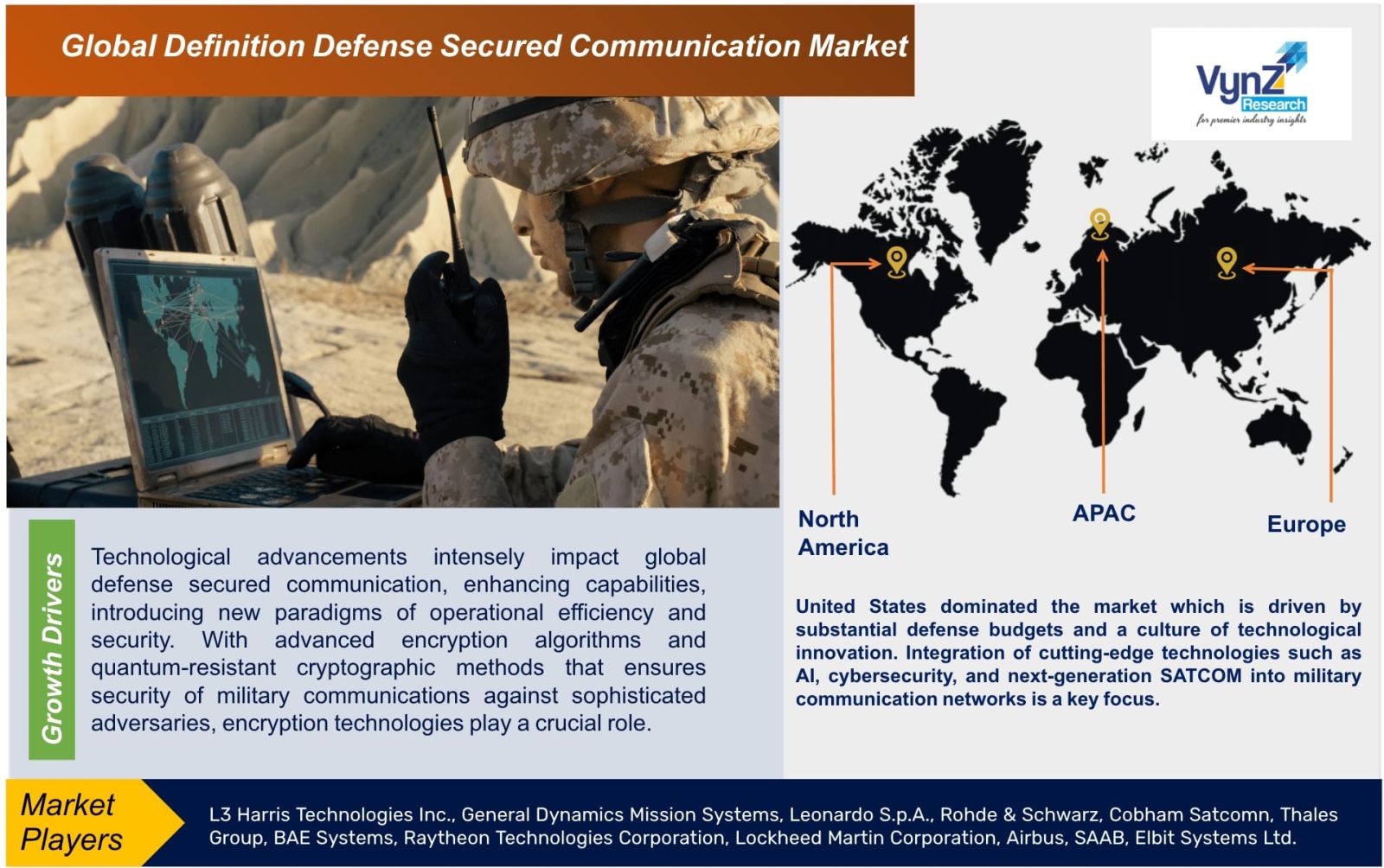| Status : Published | Published On : Jun, 2024 | Report Code : VRAD12031 | Industry : Aerospace and Defense | Available Format :

|
Page : 200 |

Global Definition Defense Secured Communication Market - Analysis and Forecast (2025-2030)
Industry Insights By Component (Hardware (Encryption Devices, Secure Radios, Satellite Communication Equipment and Others (Secure Communication Headsets)), Software (Encryption Software, Secure Email and Messaging Platform, Secure Video Conferencing Platform, Secure Network Protocols and Others (Inventory Management Software, etc.)) and Services (Maintenance and Support and Morale and Welfare Services), By Application (Command and Control, Intelligence, Surveillance and Reconnaissance (ISR), Routine Operations and Combat), By End-user (Airforce, Naval Force and Ground Force) and By Geography (North America, Europe, Asia-Pacific and Rest of the World )
Industry Overview
The Global Definition Defense Secured Communication Market is anticipated to grow from USD 6.90 billion in 2023 to USD 14.2 billion in 2030 at a CAGR of 7.4% during the forecast period from 2025 to 2030.

Global defense secured communication is specialized system that is used by military and defense organizations to effectively transmit sensitive data securely. These systems ensure confidentiality, integrity, and availability of communication channels further safeguarding military operations, and strategic plans, etc. The communication system employs advanced encryption and authentication methods to protect the data from unauthorized access and interception, jamming and other forms of electronic warfare. These systems are essential for maintaining operational security, coordinating complex maneuvers and ensuring real-time situational awareness in both peacetime and conflict scenarios.
Market Segmentation
Insight by Component
Based on component, the Global Definition Defense Secured Communication Market is segmented into hardware, software and services. The hardware segment further is segregated into, Encryption Devices, Secure Radios, Satellite Communication Equipment and Others (Secure Communication Headsets). Software segment is divided into Encryption Software, Secure Email and Messaging Platform, Secure Video Conferencing Platform, Secure Network Protocols and Others (Inventory management Software, etc.). Services segment is segmented into Maintenance and Support and Morale and Welfare Services. Among these, hardware dominates the Global Defence Secured Communication Market where Encryption Devices are majorly used for secured communication in defense. Also, these devices protect classified military plans, strategic communications, and intelligence data from interception and unauthorized access. As defense operations increasingly rely on digital communication, the need to safeguard information against cyber threats, eavesdropping, and data breaches has become the priority.
Insight by Application
The Global Definition Defense Secured Communication Market is segregated into Command and Control, Intelligence, Surveillance and Reconnaissance (ISR), Routine Operations and Combat. The Intelligence, Surveillance and Reconnaissance (ISR) applications have rapid growth in this market because of their ability to enhance situational awareness and improve operational capabilities. Military communications offer an advantage by capturing real time data, images and information which are required by the defense forces to monitor and respond threats, if any.
Insight by Enduser
The Global Definition Defense Secured Communication Market is segmented into airforce, naval force and ground force. Among these, ground forces dominated the market as they operate in diverse and challenging environments. Secured communication is vital for transmitting crucial information in these complex environments. Furthermore, ground forces handle sensitive and classified information like data related to enemy positions and tactical plans. Consequently, armed forces and intelligence services in countries like the US, India, etc., have been increasingly adopting secured communication solutions to safeguard their communications.
Global Definition Defense Secured Communication Market Report Coverage
|
Report Metric |
Details |
|
Historical Period |
2018 - 2023 |
|
Base Year Considered |
2024 |
|
Forecast Period |
2025 - 2030 |
|
Market Size in 2024 |
U.S.D. 6.90 Billion |
|
Revenue Forecast in 2030 |
U.S.D. 14.2 Billion |
|
Growth Rate |
7.4% |
|
Segments Covered in the Report |
By Component, By Application, By End-user |
|
Report Scope |
Market Trends, Drivers, and Restraints; Revenue Estimation and Forecast; Segmentation Analysis; Impact of COVID-19; Companies’ Strategic Developments; Market Share Analysis of Key Players; Company Profiling |
|
Regions Covered in the Report |
North America, Europe, Asia-Pacific and Rest of the World |
Industry Dynamics
Growth Drivers
Technological advancements intensely impact global defense secured communication, enhancing capabilities, introducing new paradigms of operational efficiency and security. With advanced encryption algorithms and quantum-resistant cryptographic methods that ensures security of military communications against sophisticated adversaries, encryption technologies play a crucial role. These technologies safeguard data confidentiality and integrity, preventing unauthorized access. As, modern military operations heavily rely on real-time data sharing, remote command and control, and collaborative decision-making across various branches and geographical locations, the need for robust and secure communication infrastructure to accommodate the seamless exchange of classified information and intelligence has increased. The evolution toward digitized and network-centric warfare strategies is a key driver augmenting the revenue growth of the Global Defense Secured Communication Market. Artificial Intelligence (AI) plays a significant role in enhancing secured communication by providing intelligent network management, automated response to threats and anomaly detection. AI-driven solutions optimize communication paths and predict potential vulnerabilities before they can be exploited. Software-Defined Radios (SDR) offer flexibility and adaptability, enabling communication systems to change frequencies, modulation schemes and protocols. This adaptability is important for avoiding detection and interference that ensures continuous secure communication in dynamic environments. Meanwhile, modern Satellite Communication (SATCOM) provides global coverage and high-bandwidth communication channels essential for remote and mobile military operations. Innovations in low-earth orbit (LEO) satellites are reducing latency and enhancing the reliability of satellite links.
Continuous innovations in communication technologies, such as quantum communication, 5G and AI is boosting the development and adoption of more advanced secured communication systems, offering superior capabilities and resilience. Nations across the world are investing in modernizing their military forces as part of military modernization programs, which include upgrading communication infrastructure that shall support more complex and integrated operations by ensuring interoperability. Efficient communication is crucial for the success of military operations that highlight the importance of continually advancing secured communication systems to meet evolving security challenges and operational demands.
Restraints
The main restraint of the Global Defense Secured Communication Market is maintaining interoperability and security among different defense branches. The defense landscape comprises a multitude of branches, agencies each using a diverse array of communication systems developed over time. Therefore, ensuring seamless interoperability among these systems while maintaining high levels of security poses a significant challenge for the defence-secured communication market players. Because of this, integrating legacy systems with new, more secure technologies often requires complex and resource-intensive efforts. This, often leads to compatibility issues, making secure communication vulnerable at points of transition.
Geographic Overview
- North America
- Europe
- Asia Pacific (APAC)
- Rest of the World
In North America, the United States dominated the market which is driven by substantial defense budgets and a culture of technological innovation. Integration of cutting-edge technologies such as AI, cybersecurity, and next-generation SATCOM into military communication networks is a key focus. Across Europe, particularly among NATO members, investments are being made in secured communication systems to enhance interoperability and collective defense capabilities. The Asia-Pacific region is experiencing rapid growth in secured communication capabilities which is due to rising defense budgets and regional security concerns. Countries like China, Japan, and South Korea are actively developing indigenous technologies and bolstering their military communication infrastructure.
Competitive Insights
The major players are actively investing in research and development, partnerships and acquisitions. Companies are striving to enhance their technological capabilities, offer innovative solutions to meet evolving customer demands and expand market reach.
General Dynamics Mission Systems integrates secure communication and information systems and technology. General Dynamics Mission Systems has core manufacturing in secure communications networks; radios and satellite technology for the defense, cyber, public safety, and intelligence communities.
L3Harris Technologies, Inc. is an American technology company, defense contractor, and information technology services provider that produces command and control systems, products and wireless equipments, , avionics and electronic systems, night vision equipment, tactical radios and both terrestrial and spaceborne antennas for use in the defense, government and commercial sectors.
Key Players Covered in the Report
Some of the key players in this market are L3 Harris Technologies Inc., General Dynamics Mission Systems, Leonardo S.p.A., Rohde & Schwarz, Cobham Satcomn, Thales Group, BAE Systems, Raytheon Technologies Corporation, Lockheed Martin Corporation, Airbus, SAAB, Elbit Systems Ltd.
Recent developments by Key Players
L3 Harris Technologies has secured a £21m (USD 26.24m) contract from the UK Ministry of Defence’s procurement arm Defence Equipment and Support (DE&S) for 50 T4 bomb disposal robots. The contract includes an initial three years of in-service maintenance and repair support.
General Dynamics Corp. to build and support AN/USC-61(C) maritime radios to enable Navy surface warships and submarines to communicate over high frequency (HF), ultra-high frequency (UHF) line of sight, UHF satellite communications (SATCOM), and very high frequency (VHF) radio bands.
Segments Covered in the Report
- Based on the Component:
- Hardware
- Encryption Devices
- Secure Radios
- Satellite Communication Equipment
- Others (Secure Communication Headsets, etc.)
- Software
- Encryption Software
- Secure Email and Messaging Platform
- Secure Video Conferencing Platform
- Secure Network Protocols
- Others (Inventory management Software, etc.)
- Services
- Maintenance and Support
- Morale and Welfare Services
- Hardware
- By Application
- Command and Control
- Intelligence, Surveillance and Reconnaissance (ISR)
- Routine Operations and Combat
- By Enduser
- Air Force
- Naval Force
- Ground Force
Region Covered in the Report
- North America
- U.S.
- Canada
- Mexico
- Europe
- Germany
- U.K.
- France
- Italy
- Spain
- Russia
- Rest of Europe
- Asia-Pacific (APAC)
- China
- Japan
- South Korea
- India
- Australia
- Rest of APAC
- Rest of the World
- Brazil
- Saudi Arabia
- South Africa
- U.A.E
- Other Countries
Purchase Options
Latest Report
Research Methodology
- Desk Research / Pilot Interviews
- Build Market Size Model
- Research and Analysis
- Final Deliverabvle
Connect With Our Sales Team
- Toll-Free: 1 888 253 3960
- Phone: +91 9960 288 381
- Email: enquiry@vynzresearch.com
